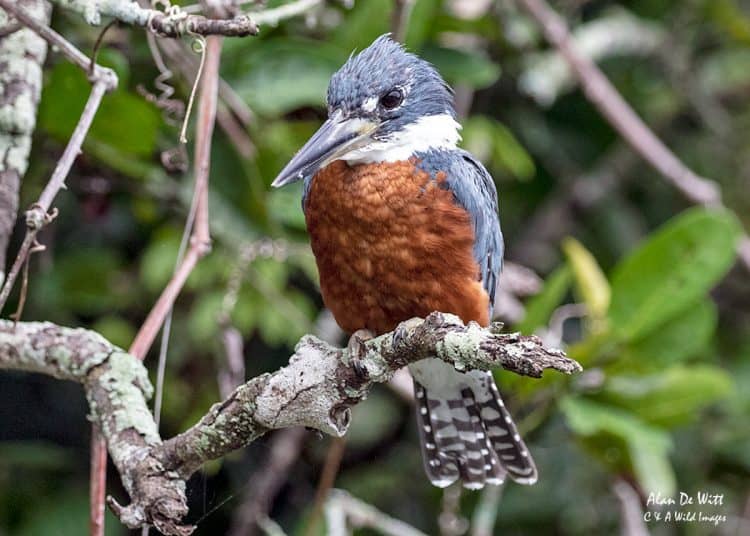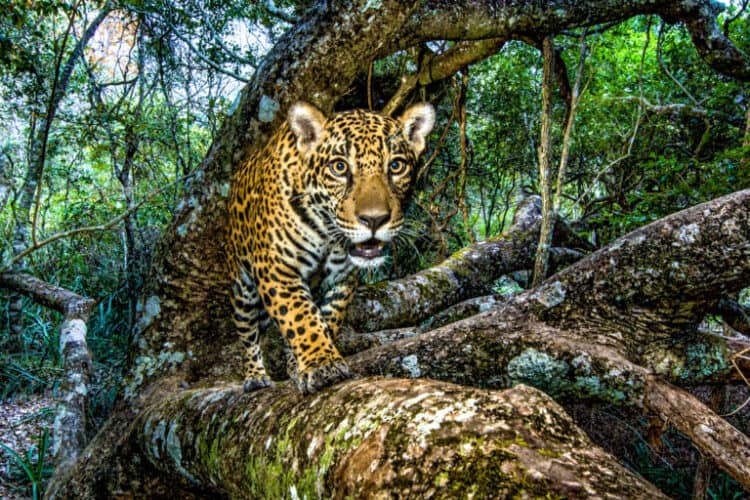Although the main focus of our trip to Brazil’s Pantanal was to see Jaguars. We had been told that the area was a paradise for birders and photographers. With over 600 species of birds to see and very few humans to disturb them we found It was often possible to get very close to many of the them. This was particularly true of the five kingfishers that in inhabited the rivers and ponds.
More about the a trip to the Pantanal and its wildlife @ https://adwimages.co.uk/just-jaguars-pantanal/
There are five Kingfisher species in the Pantanal
- Ringed Kingfisher
- Amazon Kingfisher
- Green Kingfisher
- Green-and-Rufous Kingfisher
- American Pigmy Kingfisher,.
Ringed Kingfisher
The largest of the five species is the Ringed Kingfisher

Reaching almost 40cm it was the most distinctive and common species we came across. It’s coloured blue-grey with a red-brown chest and easily seen along the river banks. They are found throughout South and Central America as far south as Tierra del Fuego and has now increased its range north to the Rio Grande in Texas.
Amazon Kingfisher
The second largest of the five species is the Amazon Kingfisher measuring about 30 cm in length.

Its’ upper parts are oily green colour with a distinctive ragged crest and a white collar. Like the ringed Kingfisher the Amazon is found around lakes and slow flowing rivers from Mexico, to central Argentina
Green-and-rufous Kingfisher
The Green-and-rufous Kingfisher is arguably the most attractive and one of the less common species we came across.

Green-and-rufous Kingfisher showing the white spotting on the wings

Green-and-rufous Kingfisher

Green-and-rufous Kingfisher
It is 24 cm in length, so not the smallest, but very difficult to spot. This is due to its’ dark glossy green upper parts, with white spotting on the wings, and a rufous nape. These all act as excellent camouflage.
Like the other kingfishers it’s found around streams and rivers. It’s distribution is from Nicaragua, through Central America and across much of the northern parts of South America, as far as Paraguay.
Green Kingfisher
Next in size is the Green Kingfisher.

Female Green Kingfisher

Male Green Kingfisher

Female Green Kingfisher showing the white spots on the wing tips
Measuring about 19 centimeters in length, it looks like a smaller version of the Amazon kingfisher. It has dark green upper parts, a white collar and a rufous breast band, Although the females lack the breast colouring.
Like all the other kingfishers they’re always found near water. However being smaller they seem to favour the smaller streams and around the edges of ponds. Here the dense low foliage provided perches close to the water.
American Pygmy Kingfisher
The smallest of the Pantanals Kingfishers is the American Pygmy Kingfisher.

American Pygmy Kingfisher

American Pygmy Kingfisher
Only reaching about 13cm in length and although wide spread in the Pantanal it was the species we encountered less frequently. This was possibly due to its minute size, and colouring. It is dark green above, with a buffy-orange collar, rufous underparts and a small white belly. They often spend their time perching on low overhanging branches, staying concealed. This makes them difficult to spot in the dense undergrowth along the banks
They range from southern Mexico south, through Central America down to central Brazil.
Alan De Witt
After spending a career that demanded much of my time and energy. I'm now retired and finally found some time to pursue an interest in wildlife and photography as well as putting together a website C & A's Wild Images.
I now live in Norfolk, an ideal location in the UK to see wildlife and over the years have also had the opportunity to visit and spend time using the camera in interesting and sometimes remote parts of the world. I first became interested in trying to capture wildlife images when I left university in the days of slide film. Initially I used two compact cameras with 20+ zooms but now have moved to a professional Canon SLR set-up.







Leave a Reply